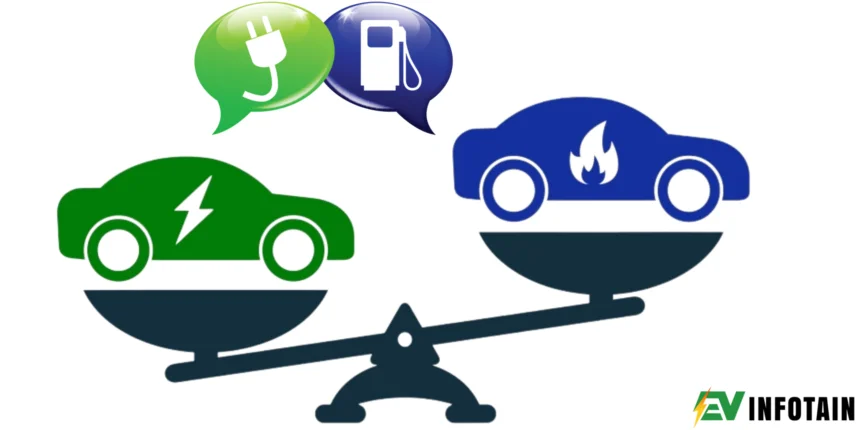In the rapidly evolving Indian automotive landscape, sustainability and eco-friendliness have taken center stage. The surge in popularity of Electric Vehicles (EVs) is a testament to this paradigm shift. Is it more cost-effective to drive an electric vehicle (EV)? What will be the total cost of ownership? This seemingly straightforward question has perplexed car buyers for some time due to various factors that impact an EV’s overall cost. Let’s unravel this question.
In this article, we will thoroughly examine the financial aspects of owning and operating two Tata vehicles. Let’s compare the Tata Nexon XZ Petrol Car and the Tata Nexon EV Car.
Initial Purchase Price
Tata Nexon XZ Petrol Car
The Tata Nexon XZ Petrol Car boasts a competitive price tag, hovering at approximately ₹10.5 lakhs (ex-showroom) in India.
Tata Nexon EV Car
In stark contrast, the Tata Nexon EV Car bears a slightly loftier price tag, commanding around ₹14.5 lakhs (ex-showroom).
It is patently clear that EVs typically present a steeper upfront cost. However, the holistic cost analysis should delve beyond this initial expense to uncover the long-term advantages and savings they bring to the table.
Cost of Electricity vs. Gasoline
Tata Nexon XZ Petrol Car
The Tata Nexon XZ Petrol Car runs on gasoline, and the cost of this fuel source can exhibit significant fluctuations based on prevailing petrol prices. Currently, petrol prices are hovering around ₹100 per liter in certain Indian cities.
Tata Nexon EV Car
Contrastingly, the Tata Nexon EV Car operates on electricity, generally commanding a lower cost per unit of energy than gasoline. In India, the average cost of electricity stands at approximately ₹8 to ₹10 per kWh. The Nexon EV features a commendable battery capacity of roughly 30 kWh, translating to a full charge cost of approximately ₹240 to ₹300.
Electric vehicles inherently boast superior energy efficiency. This ensures that you extract more mileage from each unit of energy, in comparison to a petrol car.
Three-Year Total Cost of Ownership Analysis
Here’s a comprehensive three-year TCO analysis for both the Tata Nexon XZ Petrol Car and the Tata Nexon EV Car. This takes into consideration an average annual driving distance of 12,000 kilometers. This time, we shall factor in insurance costs alongside fuel and maintenance expenses.
Tata Nexon XZ Petrol Car
· Fuel costs (₹100 per liter): ₹36,000/year x 3 years = ₹1,08,000
· Maintenance costs (average): ₹15,000/year x 3 years = ₹45,000
· Insurance costs (average): ₹10,000/year x 3 years = ₹30,000
· Total TCO over three years: ₹1,83,000
Tata Nexon EV Car (Home Charging)
· Electricity costs (₹7 per kWh): ₹7,000/year x 3 years = ₹21,000
· Maintenance costs (typically lower for EVs): ₹10,000/year x 3 years = ₹30,000
· Insurance costs (average): ₹10,000/year x 3 years = ₹30,000
· Total TCO over three years: ₹81,000
Tata Nexon EV Car (Public Charging)
For a more exhaustive analysis, let’s also factor in the cost of public charging, assuming a rate of ₹10 per kWh. The weekly charging costs for the Nexon EV Car at this rate amount to approximately ₹700.
· Yearly public charging costs: ₹700/week x 52 weeks = ₹36,400
· Total TCO over three years (inclusive of public charging): ₹1,53,400
The divergence in costs is strikingly evident as we compare these figures. The Tata Nexon EV Car, when charged at home, emerges as substantially more economical to operate over a three-year period. This cost advantage primarily stems from its lower fuel, maintenance, and insurance expenses. However, it’s noteworthy that public charging does increase the cost, albeit still remaining more affordable than the petrol variant.
Lifetime Total Cost of Ownership for Electric vs. Gas Cars
When contemplating the Total Cost of Ownership for the lifetime of a vehicle, encompassing purchase price, operational costs, and maintenance, electric vehicles frequently establish themselves as the more financially prudent choice in the long run. Despite the higher initial acquisition cost, the subsequent savings related to electricity, maintenance, and potential incentives culminate in substantial cost reductions over the vehicle’s lifetime.
Indian Government Incentives for Electric Cars
To make the transition to electric mobility even more enticing, the Indian government has proactively promoted the adoption of EVs through a slew of incentives and policy initiatives:
· FAME India Scheme: The Faster Adoption and Manufacturing of Hybrid and Electric Vehicles (FAME) India scheme extends financial incentives, including subsidies on the purchase of electric vehicles and the augmentation of charging infrastructure.
· GST Benefits: Electric vehicles are entitled to reduced GST rates compared to their petrol or diesel counterparts, rendering them more economical.
· State-Specific Incentives: Several Indian states offer additional incentives, such as road tax exemptions and reduced registration fees, to incentivize the adoption of electric cars.
Conclusion
In conclusion, when considering the Total Cost of Ownership (TCO), electric cars like the Tata Nexon EV prove to be a financially savvy choice for Indian consumers. Despite the higher initial purchase price, the lower operating costs, government incentives, and positive environmental impact make EVs a compelling option in the long term.
As India continues to invest in electric vehicle infrastructure and policies, the financial benefits of owning an electric car are expected to become even more compelling. When making the transition to electric mobility, it’s crucial to weigh not only the upfront costs but also the long-term financial advantages and environmental benefits.

